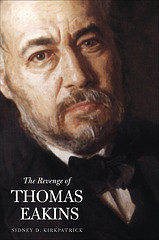
This week’s Weekly includes my review of the new Sidney Kirkpatrick biography “The Revenge of Thomas Eakins,” a book I want to highly recommend as a great read. Not only does it have lots of details about the city but it’s a rich, nuanced portrait of a difficult, complicated man who was a tortured genius. Here’s the link to the art page and below is the copy with more pictures.
Sculls and Bones
Thomas Eakins was ambitious, hardworking, charismatic, opinionated, stubborn and a mischief-maker. It’s that combination of characteristics that fueled the artist’s genius-and turned him into a local pariah who packed a pistol when he ventured out at night for fear his enemies were out to get him.
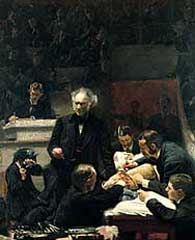
The Gross Clinic, 1875, perhaps his best-known painting, controversial for its blood and realism which shocked and dismayed most of his contemporaries.
As chronicled in Sidney D. Kirkpatrick’s new biography The Revenge of Thomas Eakins, the painter of psychologically incisive portraits and all those rowing pictures was a character out of step with his Victorian era, and his troubles were partly self-inflicted.
(Read a Q&A with Kirkpatrick on the publisher’s website.)
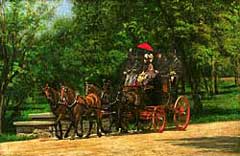
Fairman Rogers Four-in-Hand, 1879. Rogers was a director of PAFA and champion of Eakins at a time when others disdained him.
Much of the story told about Eakins in Kirkpatrick’s book isn’t new. In fact the book fleshes out source material discovered by curator Kathleen Foster in 1983 and now in the Pennsylvania Academy of the Fine Arts archives (the Charles Bregler cache of Eakins’ personal correspondence and papers). The author also draws on the scholarship of the eye-opening 2001 Thomas Eakins exhibition at the Philadelphia Museum of Art, which brought to light the artist’s use of photography to work out compositions. (The PMA has redone its website to include generous text and pictures about their exhibits. Here’s the Eakins exhibit online — not the entire 60 works from the show, but it’s pretty comprehensive.)
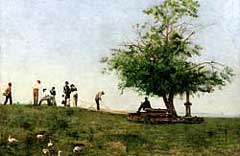
Mending The Net, 1881, a painting based on several photographs the artist took which he then collaged together to create an image
But the book’s value is that it’s a general-interest biography, not a scholarly tome. Kirkpatrick brings Eakins to life as a breathing, sweating, prickly and fascinating man, one a wide audience will appreciate. This is the artist as hero who’s both visionary and vulnerable. And his life, if not exemplary, is a cautionary tale about getting along in the greater world.
Rich in details about the history of the time and told in compact, almost cinematic episodes with many illustrations, the book is a page-turner even though you know the outcome. Philadelphia is a wonderful backdrop for the story-a big metropolis and center for medicine, education and industry, and a city with great physical beauty where both rivers are accessible for recreation and Fairmount Park is a crown jewel.

What helped fuel controversy about the artist was his espousal of nude modelling. He was always trying to get people to unrobe and pose for him. He made many photographic studies of the nude, like this one.
There are pages about the rigorous curriculum at Central High School, where Eakins graduated fifth in his class in 1861, and pages about Jefferson Medical College, where the artist completed a year of studies before deciding to turn his full attention to art.
Gossip stuck like glue to the larger-than-life Eakins, who by all accounts was a handsome leader. At a time of great cultural prudishness he was unabashedly pro-nudity. Twice he pulled the loincloths off male models in a coed art class to reveal the body’s beauty (once at the Academy and later at Drexel). Eakins inflamed the imaginations of many. When impressionable young female students made accusations of sexual misconduct against him, everyone was inclined to believe the accusers-though judging from documents unearthed in the Bregler cache, it now seems they fabricated their stories.
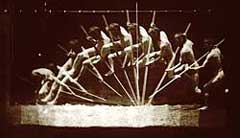
Motion Study: George Reynolds, nude, pole-vaulting to left, 1885. Eakins worked on a project with Eadward Muybridge to make thousands of photographic studies of the figure in motion. Eakins in fact invented a device that allowed multiple photos to be taken by the same camera (instead of many cameras positioned in a row–Muybridge’s technique.)
Eakins’ life had moments of sheer hell, injustice and tragedy. Kirkpatrick says his revenge is that he became as big as the city and is an indispensable civic icon. We name a traffic circle for him and we claim his glory as our own.
The Revenge of Thomas Eakins
By Sidney D. Kirkpatrick
Yale University Press









